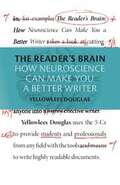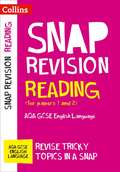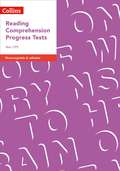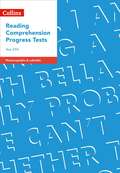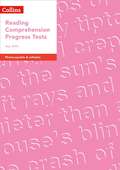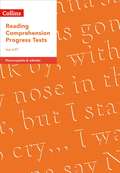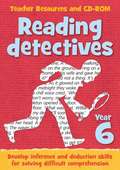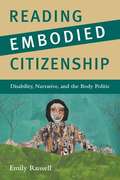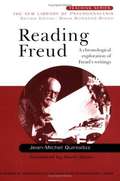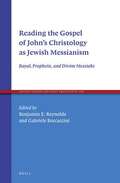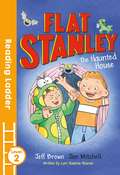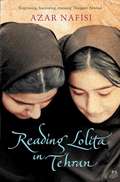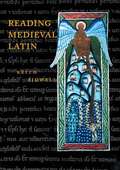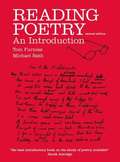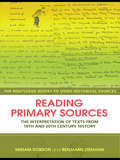- Table View
- List View
The Reader's Brain (PDF): How Neuroscience Can Make You A Better Writer
by Yellowlees DouglasHave you ever found yourself re-reading the same sentence four or five times and thought 'I should get more sleep'? Are you clueless as to why one paragraph just seems to 'flow' while you simply can't recall the contents of another? Guess what: you are not alone. Even the best writers fail to grasp why their writing works. The Reader's Brain is the first science-based guide to writing, employing cutting-edge research on how our minds process written language, to ensure your writing can be read quickly, assimilated easily, and recalled precisely - exactly what we need to transform anyone into a highly effective writer. Using the 5Cs - clarity, continuity, coherence, concision, and cadence - this book combines irreverent humour with easy-to-follow principles that will make readers perceive your sentences, paragraphs, and documents to be clear, concise, and effective.
Reading: AQA GCSE English Language (PDF) (for papers 1 and #2)
by Collins Collins GcseExam Board: AQA Level & Subject: GCSE English Language First teaching: September 2015 First exams: June 2017 Revise tricky topics in a snap Collins Snap Revision helps you focus on the areas of your revision that you find tricky or need extra practice in. Spaced practice opportunities allow you to test, revisit and review your understanding throughout your revision, a method proven to improve your performance in the exam. * Focussed revision in tricky areas of the exam * Targeted practice in specific areas where more support may be needed * Ideal to use at home
Reading Comprehension Progress Tests Year 1/P2 (PDF)
by Shelley WelshCheck pupils are on track and making expected progress with six reading comprehension tests for Year 1/P2. Carefully selected extracts provide a range of vocabulary, styles and content to build reading skills towards SATs. Photocopiable and editable, these informal tests help identify gaps in learning and next steps. Assess pupils’ comprehension skills in Year 1 with questions that gradually introduce SATs style language to help build familiarity for end of KS1 tests. Measure progress every half term with short, illustrated, cross curricular fiction, non-fiction and poetry comprehension tests. Check pupils are on track for the expected standard with guidance and SATs style mark schemes. Save time with high quality tests written by primary literacy experts and a range of unseen age-appropriate extracts. Easy to use with national curriculum objectives and content domain references set out in a yearly overview. Available for Years 1–6/P2–P7, you can provide a consistent and systematic way of assessing reading comprehension in your school.
Reading Comprehension Progress Tests Year 3/P4 (PDF)
by Josh LuryCheck pupils are on track and making expected progress with six reading comprehension tests for Year 3/P4. Carefully selected extracts provide a range of vocabulary, styles and content to build reading skills towards KS2 SATs. Photocopiable and editable, these informal tests help identify gaps in learning and next steps. Assess pupils’ comprehension skills in Year 3 with questions that use SATs style language to help build familiarity and confidence for end of KS2 tests. Measure progress every half term with illustrated, cross curricular fiction, non-fiction and poetry comprehension tests. There are two extracts per test. Check pupils are on track for the expected standard with guidance and SATs style mark schemes. Save time with high quality tests written by primary literacy experts and a range of unseen age-appropriate extracts. Easy to use with national curriculum objectives and content domain references set out in a yearly overview.Available for Years 1–6/P2–P7, you can provide a consistent and systematic way of assessing reading comprehension in your school.
Reading Comprehension Progress Tests Year 4/P5 (PDF)
by Josh LuryCheck pupils are on track and making expected progress with six reading comprehension tests for Year 4/P5. Carefully selected extracts provide a range of vocabulary, styles and content to build reading skills towards KS2 SATs. Photocopiable and editable, these informal tests help identify gaps in learning and next steps. Assess pupils’ comprehension skills in Year 4 with questions that use SATs style language to help build familiarity and confidence for end of KS2 tests. Measure progress every half term with illustrated, cross curricular fiction, non-fiction and poetry comprehension tests. There are two extracts per test. Check pupils are on track for the expected standard with guidance and SATs style mark schemes. Save time with high quality tests written by primary literacy experts and a range of unseen age-appropriate extracts. Easy to use with national curriculum objectives and content domain references set out in a yearly overview. Available for Years 1–6/P2–P7, you can provide a consistent and systematic way of assessing reading comprehension in your school.
Reading Comprehension Progress Tests Year 6/P7 (PDF)
by Stephanie AustwickCheck pupils are on track and making expected progress with six reading comprehension tests for Year 6/P7. Carefully selected longer extracts provide a range of vocabulary, styles and content to build reading skills and stamina towards KS2 SATs. Photocopiable and editable, these informal tests help identify gaps in learning and next steps. Assess pupils’ comprehension skills in Year 6 with questions that use SATs style language to help build confidence and prepare for end of KS2 tests. Measure progress every half term with illustrated, reading comprehension tests which cover stories, non-fiction, poetry and plays. There are two extracts per test. Check pupils are on track for the expected standard with guidance and SATs style mark schemes. Save time with high quality tests written by primary literacy experts and a range of unseen age-appropriate extracts. Easy to use with national curriculum objectives and content domain references set out in a yearly overview. Available for Years 1–6/P2–P7, you can provide a consistent and systematic way of assessing reading comprehension in your school.
Reading & Comprehension Workbook Age 9-11
by Susan ElkinSolid and rigorous practice material in reading and comprehension for children to work on throughout the year, and in preparation for pre-tests and 11 Plus Common Entrance exams.
Reading Detectives: Teacher Resources and CD-ROM (PDF)
by Keen Kite Books StaffPrepare children for the most difficult aspects of their reading test with comprehension exercises that concentrate on developing the key skills of inference and deduction. Prepare children for the most difficult aspects of their reading test with comprehension exercises that concentrate on developing the key skills of inference and deduction. * Set questions that gradually progress pupils' skills and deeper understanding of a text * Increase vocabulary and reading stamina with extracts from a rich variety of fiction and non-fiction texts * Evaluate your pupils' responses and help them apply their skills to other texts with guidance from top literacy consultant Rachel Clarke Included texts: Romulus and Remus: Twin Boys who Founded Rome by Geraldine McCaughrean When Hitler Stole Pink Rabbit by Judith Kerr The Purple Lady by Jamila Gavin I am Malala by Malala Yousafzai with Patricia McCormick The Visitor by Ian Serraillier The Mystery of the Clockwork Sparrow by Katherine Woodfine Arthur: High King of Britain by Michael Morpurgo The Cloudspotter's Guide by Gavin Pretor-Pinney Five Children and It by E. Nesbit Oddiputs by Nicholas Fisk Africa: Eye to Eye with the Unknown by Michael Bright Fenn Halflin and the Fearzero by Francesca Armour-Chelu Cowboy Song by Charles Causley The Great Adventures of Sherlock Holmes: The Engineer's Thumb by Sir Arthur Conan Doyle The Tempest by William Shakespeare
Reading Educational Research and Policy (Learning About Teaching Ser.)
by David ScottReading Educational Research and Policy will improve the ability of teachers to deconstruct policy, research and media texts. This accessible book examines in turn the message systems through which educational meanings are conveyed in modern society: official policy texts; written media and spoken media. Through understanding how and why messages are conveyed, teachers will develop strategies for becoming more critical and reflective of the texts that confront them in their work.
Reading Educational Research and Policy (Learning About Teaching Ser.)
by David ScottReading Educational Research and Policy will improve the ability of teachers to deconstruct policy, research and media texts. This accessible book examines in turn the message systems through which educational meanings are conveyed in modern society: official policy texts; written media and spoken media. Through understanding how and why messages are conveyed, teachers will develop strategies for becoming more critical and reflective of the texts that confront them in their work.
Reading Embodied Citizenship: Disability, Narrative, And The Body Politic
by Emily RussellLiberal individualism, a foundational concept of American politics, assumes an essentially homogeneous population of independent citizens. When confronted with physical disability and the contradiction of seemingly unruly bodies, however, the public searches for a story that can make sense of the difference. The narrative that ensues makes "abnormality" an important part of the dialogue about what a genuine citizen is, though its role is concealed as an exception to the rule of individuality rather than a defining difference. Reading Embodied Citizenship brings disability to the forefront, illuminating its role in constituting what counts as U. S. citizenship. Drawing from major figures in American literature, including Mark Twain, Flannery O'Connor, Carson McCullers, and David Foster Wallace, as well as introducing texts from the emerging canon of disability studies, Emily Russell demonstrates the place of disability at the core of American ideals. The narratives prompted by the encounter between physical difference and the body politic require a new understanding of embodiment as a necessary conjunction of physical, textual, and social bodies. Russell examines literature to explore and unsettle long-held assumptions about American citizenship.
Reading Freud: A Chronological Exploration Of Freud's Writings
by Jean-Michel QuinodozReading Freud provides an accessible outline of the whole of Freud's work from Studies in Hysteria through to An Outline of Psycho-Analysis. It succeeds in expressing even the most complex of Freud's theories in clear and simple language whilst avoiding over-simplification. Each chapter concentrates on an individual text and includes valuable background information, relevant biographical and historical details, descriptions of Post-Freudian developments and a chronology of Freud's concepts. By putting each text into the context of Freud's life and work as a whole, Jean-Michel Quinodoz manages to produce an overview which is chronological, correlative and interactive. Texts discussed include: * The Interpretation of Dreams * The 'Uncanny' * Civilisation and its Discontents The clear presentation, with regular summaries of the ideas raised, encourages the reader to fully engage with the texts presented and gain a thorough understanding of each text in the context of its background and impact on the development of psychoanalysis. psychoanalysis, Jean-Michel Quinodoz has produced a uniquely comprehensive presentation of Freud's work which will be of great value to anyone studying Freud and Psychoanalysis. 9781583917473 1583917462 1583917470
Reading Freud: A Chronological Exploration Of Freud's Writings (PDF)
by Jean-Michel QuinodozReading Freud provides an accessible outline of the whole of Freud's work from Studies in Hysteria through to An Outline of Psycho-Analysis. It succeeds in expressing even the most complex of Freud's theories in clear and simple language whilst avoiding over-simplification. Each chapter concentrates on an individual text and includes valuable background information, relevant biographical and historical details, descriptions of Post-Freudian developments and a chronology of Freud's concepts. By putting each text into the context of Freud's life and work as a whole, Jean-Michel Quinodoz manages to produce an overview which is chronological, correlative and interactive. Texts discussed include: * The Interpretation of Dreams * The 'Uncanny' * Civilisation and its Discontents The clear presentation, with regular summaries of the ideas raised, encourages the reader to fully engage with the texts presented and gain a thorough understanding of each text in the context of its background and impact on the development of psychoanalysis. psychoanalysis, Jean-Michel Quinodoz has produced a uniquely comprehensive presentation of Freud's work which will be of great value to anyone studying Freud and Psychoanalysis. 9781583917473 1583917462 1583917470
Reading The Gospel Of John's Christology As Jewish Messianism: Royal, Prophetic, And Divine Messiahs (Ancient Judaism And Early Christianity Ser. #106)
by Benjamin Reynolds Gabriele BoccacciniReading Ladder Level 2: Flat Stanley: The Haunted House (PDF)
by Lori Haskins Houran Jon Mitchell Jeff BrownA spooky but funny story about Jeff Brown’s Flat Stanley – everyone’s favourite flat boy – perfect for children learning to read. Stanley and his brother Arthur are going to their school's Halloween party. They dress up in costumes and Stanley is particularly looking forward to the limbo competition. They're rather disappointed by the haunted house, though - it's really not very scary. But when they see a bully upsetting their friend Martin, they decide to teach him a lesson - by being very scary indeed! The Reading Ladder series helps children to enjoy learning to read. It features well-loved authors, classic characters and favourite topics, so that children will find something to excite and engage them in every title they pick up. It’s the first step towards a lasting love of reading. Level 2 Reading Ladder titles are perfect for readers who are growing in confidence and are beginning to enjoy longer stories. • Clear type • Up to 8 lines per page • Bright, appealing pictures for added interest • A variety of sentence structures • A wider range of vocabulary • Strong themes and characters to discuss All Reading Ladder titles are developed with a leading literacy consultant, making them perfect for use in schools and for parents keen to support their children’s reading.
Reading Like a Writer: A Guide for People Who Love Books and for Those Who Want to Write Them
by Francine ProseIn her entertaining and edifying New York Times bestseller, acclaimed author Francine Prose invites you to sit by her side and take a guided tour of the tools and tricks of the masters to discover why their work has endured. Written with passion, humour and wisdom, Reading Like a Writer will inspire readers to return to literature with a fresh eye and an eager heart – to take pleasure in the long and magnificent sentences of Philip Roth and the breathtaking paragraphs of Isaac Babel; to look to John le Carré for a lesson in how to advance plot through dialogue and to Flannery O’Connor for the cunning use of the telling detail; to be inspired by Emily Brontë’s structural nuance and Charles Dickens’s deceptively simple narrative techniques. Most importantly, Prose cautions readers to slow down and pay attention to words, the raw material out of which all literature is crafted, and reminds us that good writing comes out of good reading.
Reading Lolita in Tehran: A Memoir in Books (PDF)
by Azar NafisiThe inspirational tale of eight women who defied the confines of life in revolutionary Iran through the joy and power of literature. 'That room for all of us, became a place of transgression. What a wonderland it was! Sitting around the large coffee table covered with bouquets of flowers … We were, to borrow from Nabokov, to experience how the ordinary pebble of ordinary life could be transformed into a jewel through the magic eye of fiction.' For two years before she left Iran in 1997, Azar Nafisi gathered seven young women at her house every Thursday morning to read and discuss forbidden works of Western literature. They were all former students whom she had taught at university. Some came from conservative and religious families, others were progressive and secular; several had spent time in jail. Shy and uncomfortable at first, they soon began to open up and speak more freely, not only about the novels they were reading but also about themselves, their dreams and disappointments. Their stories intertwined with those they were reading – ‘Pride and Prejudice’, ‘Washington Square’, ‘Daisy Miller’ and ‘Lolita’ – their Lolita, as they imagined her in Tehran. Nafisi's account flashes back to the early days of the revolution when she first started teaching at the University of Tehran amid the swirl of protests and demonstrations. In those frenetic days, the students took control of the university, expelled faculty members and purged the curriculum. Azar Nafisi's luminous tale offers a fascinating portrait of the Iran-Iraq war viewed from Tehran and gives us a rare glimpse, from the inside, of women's lives in revolutionary Iran. It is a work of great passion and poetic beauty, written with a startlingly original voice.
Reading Mathematics In Early Modern Europe
by Philip Beeley Yelda Nasifoglu Benjamin WardhaughLibraries and archives contain many thousands of early modern mathematical books, of which almost equally many bear readers' marks, ranging from deliberate annotations and accidental blots to corrections and underlinings. Such evidence provides us with the material and intellectual tools for exploring the nature of mathematical reading and the ways in which mathematics was disseminated and assimilated across different social milieus in the early centuries of print culture. Other evidence is important, too, as the case studies collected in the volume document. Scholarly correspondence can help us understand the motives and difficulties in producing new printed texts, library catalogues can illuminate collection practices, while manuscripts can teach us more about textual traditions. By defining and illuminating the distinctive world of early modern mathematical reading, the volume seeks to close the gap between the history of mathematics as a history of texts and history of mathematics as part of the broader history of human culture.
Reading Mathematics In Early Modern Europe
by Philip Beeley Yelda Nasifoglu Benjamin WardhaughLibraries and archives contain many thousands of early modern mathematical books, of which almost equally many bear readers' marks, ranging from deliberate annotations and accidental blots to corrections and underlinings. Such evidence provides us with the material and intellectual tools for exploring the nature of mathematical reading and the ways in which mathematics was disseminated and assimilated across different social milieus in the early centuries of print culture. Other evidence is important, too, as the case studies collected in the volume document. Scholarly correspondence can help us understand the motives and difficulties in producing new printed texts, library catalogues can illuminate collection practices, while manuscripts can teach us more about textual traditions. By defining and illuminating the distinctive world of early modern mathematical reading, the volume seeks to close the gap between the history of mathematics as a history of texts and history of mathematics as part of the broader history of human culture.
Reading Medieval Latin
by Keith C. SidwellReading Medieval Latin is an anthology of Medieval Latin texts, arranged chronologically and thematically with introductions, commentaries and a vocabulary of nonclassical words and meanings. It is a language textbook, designed to introduce students with one year or more of Latin to the Latin writing and culture of the period A. D. 550-1200. It is the only systematic introduction for students to all types of Medieval Latin writing.
Reading Mill (PDF): Studies In Political Theory
by Ian CookReading Mill begins with the idea that political theory, as it is understood and practised in Anglophone Universities, is not one practice but a set of four alternative practices marked by divergent ontologies and epistemologies. Three of the conceptions of political theory identified are applied to produce markedly different readings of the works of John Stuart Mill. The work is designed to demonstrate that the alternative conceptions of political theory are coherent and offer different insights into Mill's works.
Reading Mill (PDF): Studies In Political Theory
by Ian CookReading Mill begins with the idea that political theory, as it is understood and practised in Anglophone Universities, is not one practice but a set of four alternative practices marked by divergent ontologies and epistemologies. Three of the conceptions of political theory identified are applied to produce markedly different readings of the works of John Stuart Mill. The work is designed to demonstrate that the alternative conceptions of political theory are coherent and offer different insights into Mill's works.
Reading Poetry: An Introduction (PDF)
by Tom Furniss Michael BathReading Poetry offers a comprehensive and accessible guide to the art of reading poetry. Successive chapters introduce key skills and critical or theoretical issues, enabling users to read poetry with enjoyment, insight and an awareness of the implications of what they are doing. This new edition includes a new chapter on 'Post-colonial Poetry', a substantial increase in the number of end-of-chapter interactive exercises, and a comprehensive Glossary of poetic terms. Not just an add-on, the Glossary works as a key resource for the structuring of particular topics in any individual teaching or learning programme. Many of the exercises and interactive discussions develop not only the skills of competent close reading but also the necessary confidence and experience in locating historical and other contextual information through library or internet searches. The aim is to enhance readers' literary and scholarly competence - and to make it fun!
Reading Poetry: An Introduction
by Tom Furniss Michael BathReading Poetry offers a comprehensive and accessible guide to the art of reading poetry. Successive chapters introduce key skills and critical or theoretical issues, enabling users to read poetry with enjoyment, insight and an awareness of the implications of what they are doing. This new edition includes a new chapter on 'Post-colonial Poetry', a substantial increase in the number of end-of-chapter interactive exercises, and a comprehensive Glossary of poetic terms. Not just an add-on, the Glossary works as a key resource for the structuring of particular topics in any individual teaching or learning programme. Many of the exercises and interactive discussions develop not only the skills of competent close reading but also the necessary confidence and experience in locating historical and other contextual information through library or internet searches. The aim is to enhance readers' literary and scholarly competence - and to make it fun!
Reading Primary Sources: The Interpretation Of Texts From 19th And 20th Century History (PDF)
by Miriam Dobson Benjamin ZiemannHow does the historian approach primary sources? How do interpretations differ? How can they be used to write history? Reading Primary Sourcesgoes a long way to providing answers for these questions. In the first part of this unique volume, the chapters give an overview of both traditional and new methodological approaches to the use of sources, analyzing the way that these have changed over time. The second part gives an overview of twelve different types of written sources, including letters, opinion polls, surveillance reports, diaries, novels, newspapers, and dreams, taking into account the huge expansion in the range of written primary sources used by historians over the last thirty years. This book is an up-to-date introduction into the historical context of these different genres, the ways they should be read, the possible insights and results these sources offer and the pitfalls of their interpretation. All of the chapters push the reader beyond a conventional understanding of source texts as mere "reflections" of a given reality, instead fostering an understanding of how each of the various genres has to be seen as a medium in its own right. Taking examples of sources from around the globe, and also including a student-friendly further reading section, this is the perfect companion for every student of history who wants to engage with sources.
